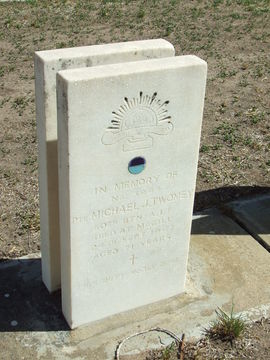
8758
TWOMEY, Michael Joseph
| Service Number: | 3944 |
|---|---|
| Enlisted: | Not yet discovered |
| Last Rank: | Private |
| Last Unit: | 10th Infantry Battalion |
| Born: | Not yet discovered |
| Home Town: | Not yet discovered |
| Schooling: | Not yet discovered |
| Occupation: | LABORER |
| Died: | 24 September 1947, cause of death not yet discovered, place of death not yet discovered, age not yet discovered |
| Cemetery: |
West Terrace Cemetery (AIF Section) Section: KO, Road: 4, Site No: 21 |
| Memorials: |
World War 1 Service
| 2 Dec 1915: | Involvement Private, 3944, 10th Infantry Battalion, --- :embarkation_roll: roll_number: '10' embarkation_place: Adelaide embarkation_ship: RMS Malwa embarkation_ship_number: '' public_note: '' | |
|---|---|---|
| 2 Dec 1915: | Embarked Private, 3944, 10th Infantry Battalion, RMS Malwa, Adelaide | |
| 11 Nov 1918: | Involvement Private, 3944 |
Help us honour Michael Joseph Twomey's service by contributing information, stories, and images so that they can be preserved for future generations.
Add my storyBiography contributed by St Ignatius' College
John Joseph Twomey was born in May 1882 into a Roman Catholic family in Cork, Ireland. Before joining the military, he worked as a labourer, a role that significantly prepared him for military life. Twomey’s Next of Kin was his sister, Mrs. M.B. Mahoney, who lived on Duglors Road in Daltonville, Cork, Ireland. He remained unmarried and did not have any children.
On the 9th August 1915, Twomey accepted into the Australian Imperial Forces at the age of 33.
Twomey embarked from Adelaide on the 2nd of December 1915, boarding RMS Malwa with the 10th Battalion as part of the 12th Reinforcements. The 10th Battalion was one of the first infantry units raised for the Australian Imperial Forces during World War I, formed in South Australia shortly after the war began in August 1914.
The 10th Battalion, which Twomey was a part of, played a vital role at Pozieres. The objective was to capture the village of Pozieres, which was strategically located on a ridge that provided a commanding view of the surrounding area. The Australians faced fierce resistance from German forces who were well entrenched and prepared for the assault. The battle was characterized by intense artillery bombardments, with both sides suffering significant losses. The Australians managed to capture Pozieres but at a great cost, with thousands of soldiers killed or wounded. The harsh conditions of trench warfare, combined with the relentless German counterattacks, made this a particularly gruelling experience for the troops. Additionally, the battle left a lasting impact on the Australian military identity, as it was one of the first major battles fought by Australian troops on the Western Front. The bravery and resilience displayed by the soldiers during the Battle of Pozieres contributed to the growing reputation of the Australian Imperial Forces in World War I.
Twomey was sent to 1st Convalescent Depot with flat Foot but was discharged to base a day latter. He became ill a few months later and was admitted to the 26th General Hospital with Laryngitis on 1st January 1917. After 6 days in hospital he returned to to duty only to be hospitalised again 8th February 1917 with frost bite. He returned to England in August 1917 marching into the No 1 Command Depot at Perham Downs. He was considered medically unfit and was repatriated back to Australia leaving England 18th October 1917 on the ship Beltana. He was discharged 13th February 1918.
Little information was found about Twomey post war. He died on the 24th of September 1947. His place of burial can be found on 161 West Terrace, West Terrace Cemetery, Adelaide, South Australia, Australia.









